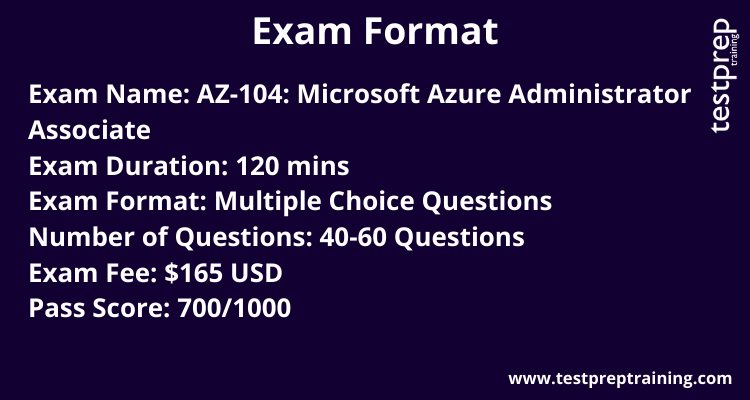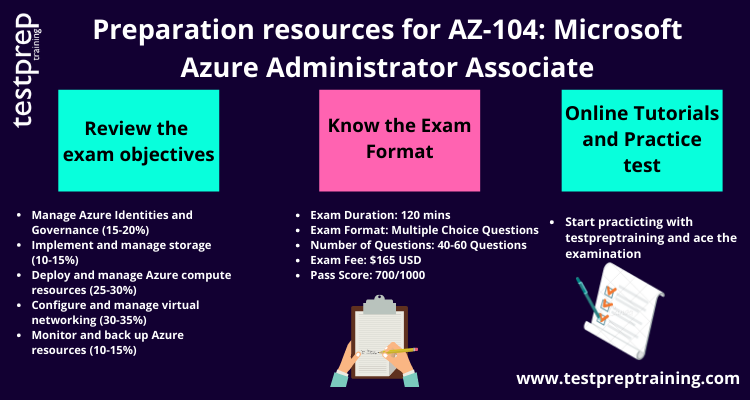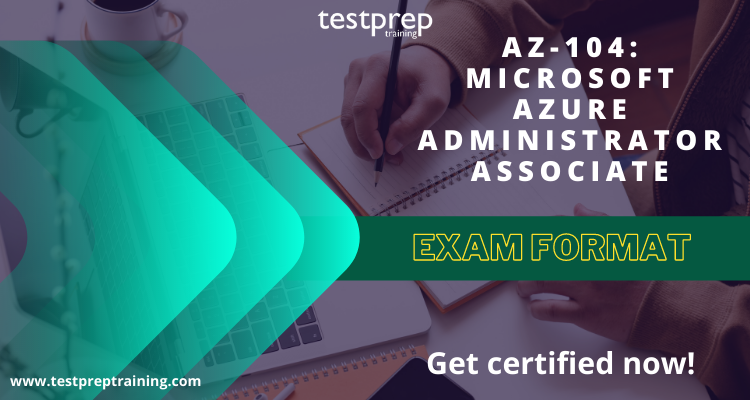The AZ-104: Microsoft Azure Administrator Associate certification exam is geared towards those who manage Cloud services that span computes, networking, storage, security, and other Cloud capabilities within Microsoft Azure. Furthermore, there is a lot of things to learn about AZ-104: Microsoft Azure Administrator Associate. But before moving forward let’s learn about Azure. Let’s start:
The role of an Azure Administrator is often associated with infrastructure-as-a-service (IaaS), which mainly involves running virtual machines (VMs) in the cloud. To excel as an Azure Administrator, it’s important to be familiar with one or both of the top hypervisor platforms in the industry.
Getting Started – Prerequisite Lessons for Azure Administrators
Everything you learn in your life, requires some basic understanding of the topic you will be studying. For the AZ-104: Microsoft Azure Administrator Associate you need study the below mentioned topics beforehand:
- Learn governance and Management in Azure
- Intro to Azure Virtual Machines
- Networking Fundamentals
- Network Security
- Using Azure CLI to control azure services
- Using Azure Powershell to automate azure tasks
- Learn data storage approach in azure
It’s also crucial to understand what abilities and information you’ll earn as a result of this certification. In a cloud setting, the AZ-104 exam will help you install, manage, and monitor identity, governance, storage, compute, and virtual networks, as well as provide, scale, monitor, and change resources as needed. This study route is constructed in such a way that it evaluates your knowledge across five distinct topic areas.
AZ-104: Microsoft Azure Administrator Glossary
Here are some common terms and concepts related to Microsoft Azure Administrator Associate (AZ-104):
- Azure Portal: A web-based interface for managing Azure services and resources.
- Understanding Azure Resource Manager (ARM): A management layer for deploying and managing Azure resources.
- Azure Virtual Machines: Virtual machines that can be created, configured, and managed in Azure.
- Learning Azure Virtual Network: A virtual network in Azure that enables communication between Azure resources.
- Azure Active Directory (Azure AD): It’s a cloud-based service for managing identity and access. It lets users access Azure resources.
- Azure Storage: A storage service that provides highly available and scalable storage for Azure resources.
- Understanding Azure App Service: A platform-as-a-service (PaaS) offering that enables developers to build, deploy, and manage web applications.
- Azure SQL Database: A managed database service in Azure that provides scalable and highly available relational databases.
- Azure Backup: A backup and recovery service in Azure that provides data protection for Azure resources.
- Understanding Azure Monitor: Azure has a monitoring service that gives you information about how well your Azure resources are doing.
These are just some of the terms and concepts related to Microsoft Azure Administrator Associate (AZ-104). Understanding these concepts is essential for passing the AZ-104 exam and successfully managing Azure resources.
AZ-104: Microsoft Azure Administrator Associate Exam Tips and Tricks
Here are some tips and tricks to help you prepare for and pass the AZ-104: Microsoft Azure Administrator Associate exam:
- Understand the exam format: The AZ-104 exam has 40-60 multiple-choice questions that you need to finish in 150 minutes. This is a computer-based test, and you’ll get a calculator to use during the exam.
- Study the exam objectives: Review the exam objectives provided by Microsoft and make sure you understand the topics covered in each section.
- Familiarize yourself with the Azure Portal: Spend time navigating the Azure Portal and become familiar with the different Azure services and their functionalities.
- Practice with Azure services: Use Azure services to practice managing and configuring them. This will help you gain hands-on experience and become more comfortable with the Azure environment.
- Review Azure documentation: Azure documentation provides detailed information on Azure services, features, and functionality. Review the documentation related to the exam objectives.
- Take practice exams: Use practice exams to assess your knowledge and identify areas where you need more practice. Microsoft provides official practice exams that can be purchased on their website.
- Join Azure communities: Join Azure communities such as Microsoft Tech Community and Azure Reddit community to connect with other Azure professionals and learn from their experiences.
- Read Microsoft Azure blog: Read the Microsoft Azure blog to stay up-to-date with the latest Azure updates, features, and best practices.
- Manage your time: Use your time wisely in the exam. Read the questions carefully, and don’t linger too long on any one question. Make sure you leave enough time to double-check your answers before submitting the exam.
- Stay calm and focused: The AZ-104 exam can be stressful, but try to stay calm and focused. Take deep breaths, and if you feel stuck on a question, move on to the next one and come back to it later.
By following these tips, you can increase your chances of passing the AZ-104: Microsoft Azure Administrator Associate exam and becoming a certified Azure Administrator.
Exam Format:
The Microsoft Azure AZ-104 exam includes 40-60 multiple-choice questions, and you have 120 minutes to answer them. It’s important to manage your time wisely. With the total number of questions, it’s suggested not to exceed 1 minute 30 seconds on each. If you complete the test in 100 minutes, you’ll have about 20 minutes to review and double-check your answers on average.
In addition, the test contains a variety of question styles, such as case studies, short answers, multiple-choice, and mark review. Because there are several sorts of questions, you might start with the case study questions. As a result, they are the most time-consuming. Short responses come next, followed by multiple-choice questions. Keep in mind that passing the exam necessitates a score of 700 or above. In addition, the exam will set you back $165 USD. Last but not least, the examination is only available in English.

How to schedule the exam?
The Microsoft Azure Administrator Associate (AZ-104) is designed to assess and confirm your skills as an Azure Administrator. Additionally, you need to have a solid grasp of fundamental Azure services, workloads, security, and governance. You can book your exam through Pearson VUE.
For registering yourself for AZ-104: Microsoft Azure Administrator Associate examination you are required to follow the following steps:
- You can book your examination with Pearson VUE.
- Follow the instructions given the site and select the available date and time slot and make the payment.
- For Non-Students interested in Technology

- For Students or Instructors

Course Structure
Topics and sections assist you in grasping the scope of the test. Without a doubt, we will study and comprehend the main topics that will be beneficial during the preparation for the AZ-104: Microsoft Azure Administrator Associate exam.
Module 1: Manage Azure identities and governance (20-25%)
1.1 Manage Microsoft Entra users and groups
- Create users and groups (Microsoft Documentation: Add or delete users using Azure Active Directory)
- Manage user and group properties
- Manage licenses in Microsoft Entra ID
- Manage external users
- Configure self-service password reset (SSPR) (Microsoft Documentation: Tutorial: Enable users to unlock their account or reset passwords using Azure Active Directory self-service password reset)
1.2 Manage access to Azure resources
- Manage built-in Azure roles
- Assign roles at different scopes
- Interpret access assignments
1.3 Manage Azure subscriptions and governance
- Implementing and managing Azure policy (Microsoft Documentation: Create and manage policies to enforce compliance)
- Configuring resource locks (Microsoft Documentation: Lock resources to prevent unexpected changes)
- Apply and manage tags on resources (Microsoft Documentation: Use tags to organize your Azure resources and management hierarchy)
- Managing resource groups (Microsoft Documentation: Move resources to a new resource group or subscription)
- Managing subscriptions (Microsoft Documentation: Organize and manage multiple Azure subscriptions)
- Manage costs by using alerts, budgets, and Azure Advisor recommendations (Microsoft Documentation: Use cost alerts to monitor usage and spending)
- Configuring management groups (Microsoft Documentation: Create management groups for resource organization and management)
Module 2: Implement and manage storage (15-20%)
2.1 Configure access to storage
- Configure Azure Storage firewalls and virtual networks
- Create and use shared access signature (SAS) tokens
- Configure stored access policies
- Manage access keys (Microsoft Documentation: Manage storage account access keys)
- Configure identity-based access for Azure Files
2.2 Configure and manage storage accounts
- Create and configure storage accounts
- Configure Azure Storage redundancy (Microsoft Documentation: Azure Storage redundancy)
- Configure object replication (Microsoft Documentation: Configure object replication for block blobs)
- Configure storage account encryption
- Manage data by using Azure Storage Explorer and AzCopy (Microsoft Documentation: Get started with AzCopy)
2.3 Configure Azure files and Azure blob storage
- Create and configure a file share in Azure Storage (Microsoft Documentation: Create an Azure file share)
- Create and configure a container in Blob Storage
- Configure storage tiers (Microsoft Documentation: Hot, Cool, and Archive access tiers for blob data)
- Configure snapshots and soft delete for Azure Files
- Configure blob lifecycle management (Microsoft Documentation: Configure a lifecycle management policy)
- Configure blob versioning
Module 3: Deploy and manage Azure compute resources (20-25%)
3.1 Automate deployment of resources by using Azure Resource Manager (ARM) templates or Bicep files
- Interpret an Azure Resource Manager template or a Bicep file
- Modify an existing Azure Resource Manager template
- Modify an existing Bicep file
- Deploy resources by using an Azure Resource Manager template or a Bicep file
- Export a deployment as an Azure Resource Manager template or convert an Azure Resource Manager template to a Bicep file
3.2 Create and configure Virtual Machines
- Create a Virtual Machine (Microsoft Documentation: Create a Windows virtual machine)
- Configure Azure Disk Encryption (Microsoft Documentation: Create and encrypt a Windows virtual machine with the Azure portal)
- Move a virtual machine to another resource group, subscription, or region (Microsoft Documentation: Move a Windows VM to another Azure subscription or resource group)
- Manage virtual machines sizes (Microsoft Documentation: Sizes for virtual machines in Azure)
- Add virtual machines disks
- Deploy virtual machines to availability zones and availability sets
- Deploy and configure an Azure Virtual Machines scale sets (Microsoft Documentation: Create a virtual machine scale set in the Azure portal)
3.3 Provision and manage containers in the Azure portal
- Create and manage an Azure container registry
- Provision a container by using Azure Container Instances
- Provision a container by using Azure Container Apps
- Manage sizing and scaling for containers, including Azure Container Instances and Azure Container Apps
3.4 Create and configure Azure App Service
- Provision an App Service plan
- Configure scaling for an App Service plan
- Create an App Service (Microsoft Documentation: App Service overview)
- Configure certificates and Transport Layer Security (TLS) for an App Service
- Map an existing custom DNS name to an App Service
- Configure a backup for an App Service (Microsoft Documentation: Back up and restore your app in Azure App Service)
- Configuring networking settings for an App Service (Microsoft Documentation: Configuring the Network)
- Configure deployment slots for an App Service
Module 4: Implement and manage virtual networking (15–20%)
4.1 Configure and manage virtual networks in Azure
- Create and configure virtual networks and subnets (Microsoft Documentation: Azure Virtual Network)
- Create and configure virtual network peering (Microsoft Documentation: Virtual network peering)
- Configure public IP addresses
- Configure user-defined network routes (Microsoft Documentation: Virtual network traffic routing)
- Troubleshoot network connectivity
4.2 Configure secure access to virtual networks
- Create and configure network security groups (NSGs) and application security groups (Microsoft Documentation: Network security groups)
- Evaluate effective security rules in NSGs (Microsoft Documentation: Effective security rules view in Azure Network Watcher)
- Implement Azure Bastion (Microsoft Documentation: Azure Bastion)
- Configure service endpoints for Azure platform as a service (PaaS)
- Configure private endpoints for Azure PaaS(Microsoft Documentation: private endpoint)
4.3 Configure name resolution and load balancing
- Configure Azure DNS
- Configure an internal or public load balancer (Microsoft Documentation: Create an internal load balancer)
- Troubleshoot load balancing (Microsoft Documentation: Troubleshoot Azure Load Balancer)
Module 5: Monitor and Maintain Azure resources (10-15%)
5.1 Monitor resources in Azure
- Interpret metrics in Azure Monitor (Microsoft Documentation: Metrics in Azure Monitor)
- Configure log settings in Azure Monitor (Microsoft Documentation: Azure Monitor Logs overview)
- Query and analyze logs in Azure Monitor(Microsoft Documentation: Get started with log queries in Azure Monitor)
- Set up alert rules, action groups, and alert processing rules in Azure Monitor (Microsoft Documentation: Create, view, and manage metric alerts using Azure Monitor)
- Configure and interpret monitoring of virtual machines, storage accounts, and networks by using Azure Monitor Insights (Microsoft Documentation: VM insights)
- Use Azure Network Watcher and Connection Monitor
5.2 Implement backup and recovery
- Create a Recovery Services vault (Microsoft Documentation: Create and configure a Recovery Services vault)
- Create Azure backup vault (Microsoft Documentation: Backup vaults overview)
- Create and configure backup policy
- Perform backup and restore operations by using Azure Backup (Microsoft Documentation: restore Azure VM data in Azure portal)
- Configure Azure Site Recovery for Azure resources (Microsoft Documentation: Azure to Azure disaster recovery architecture)
- Perform failover to a secondary region by using Site Recovery (Microsoft Documentation: Failover Azure VMs to a secondary region)
- Configure and interpret reports and alerts for backups (Microsoft Documentation: Configure Azure Backup reports)
Preparation resources for AZ-104: Microsoft Azure Administrator Associate
It should be obvious if you know where to begin while studying for any certification or exam. We have gathered a few materials that you may use to aid in your preparation. Furthermore, following this study guide will assist you in learning and comprehending each exam’s goals. We are here to provide you with the greatest studying tools so that you can pass the exam. Furthermore, we will provide a full description to assist you in preparing for the test. Let’s get started:

Online Tutorials
Online Tutorials boost your understanding and provide a deeper insight into the exam concepts. They also include information about exam details and policies. These tutorials offer comprehensive information about the examination, ultimately aiding in thorough exam preparation. So, using online tutorials will enhance and strengthen your preparation.
Expert Corner
As you start preparing, it’s crucial to go through all the exam objectives. This will give you a clear understanding of the various topics and skills you need to master. Reviewing the exam objectives eliminates any confusion and lets you concentrate on your preparation. It helps reinforce the modules and their subtopics. Additionally, exploring different books and joining the Microsoft community connects you with people sharing similar interests, enhancing your learning experience.
To achieve success, it’s crucial to put what you’ve learned into practice. Taking a practice test is an excellent way to vary your study approach and ensure optimal results in the actual exam. Furthermore, analyzing the practice test is very important so as to ensure complete preparation. We provide you with free sample papers to help you excel in the examination. Moreover, these free practice exam papers will give you a real-time examination feel. Therefore, start preparing now!



